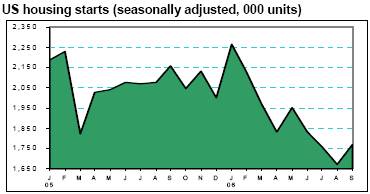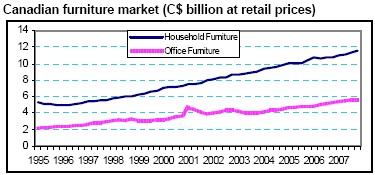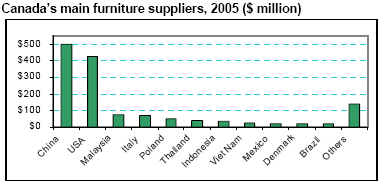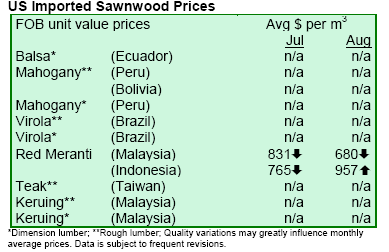|
US house starts show partial recovery in September
Privately-owned housing starts rose 5.9% in September to a seasonally
adjusted annual rate of 1.77 million units, according to the US Commerce
Department. However, this was 17.9% below the pace of a year ago. The surge
was due to a 4.3% gain in the single-family sector, which
accounted for about 80% of the houses built. Favourable weather in the US
South and Midwest was believed to be the reason for the rebound in
construction. Other than that, analysts think that the correction in the
housing sector would continue through 2007. The chart below shows that
privately-owned housing starts have plunged 22% since January this year.
Meanwhile, building permits dropped (down 6.3% from August) while housing
completions recovered (up 11.1%) in September.

House prices fall for second consecutive month
Prices for newly built homes suffered the largest drop in September year-on-year since 1970, highlighting the
downturn of the US housing sector. The median price of a new home fell to $217,100 in September, down 9.7% from
the same month a year earlier while average house prices fell 2.1%, the second consecutive monthly decline.
Canadian furniture market chalks steady growth
Canada¡¯s economy is performing slightly better than the USA¡¯s. It grew at a rate of 2.9% last year and was
expected to growth at that pace this year and to slow down moderately in 2007. The growth of the Canadian
residential housing market decelerated in 2005 to a still healthy 3.2% (on a value basis), down from 7.8% the year
before. The market is saturated now and demand is waning. Aktrin predicts a growth rate of 3.6% in 2006. If
mortgage rates continue to climb, it might even fall below 2% in 2007. This represents a drop from 225,000 units in
2006 to less than 200,000 units next year.
Canadian consumer spending is an important force contributing to the economy¡¯s overall growth. It rose at a
rate of 3.9% in 2005 and is expected to rise 4.1% this year. Due to the slowing economy and rising interest rates,
Aktrin anticipates growth to slow to about 3% in 2007.
Expenditures for durable consumer goods (which include furniture and other wooden household products) were
more buoyant than overall consumption. Growth rose from 2.5% in 2004 to a healthy 5.8% in 2005, compared with
3.9% for overall consumption. This year¡¯s rate is expected
to be similar. However, if consumer confidence declines and interest rates continue to climb, durable consumer
good sales could advance by only 3.5% next year.
 ¡¡ ¡¡
The Canadian furniture market (at retail prices) has been plowing ahead without interruption since the third quarter
of 2002. The market grew 6.2% to C$10.2 billion (at retail prices) in 2005. Aktrin estimates that growth would
continue at a similar pace this year and would slowdown
to a still respectable 4.4% in 2007. This would value the market at C$10.8 billion in 2006 and C$11.3 billion in
2007.
Strong currency might slow office furniture sales
Healthy corporate earnings are a significant driving force for office furniture consumption. Canadian business
profits (pre-tax) rose by a whooping 18.3% in 2004 and another 10.6% last year. Unfortunately, corporate
profitability might be affected by the strength of the Canadian dollar. Aktrin estimates that pre-tax profit
growth in Canada could drop to about 6.1% in 2006 and even lower next year.
Business investments are strongly influenced by corporate profits, albeit with a considerable time lag. Investments in
machinery and equipment rose by 10.5% last year and Aktrin anticipates a similar rate for 2006. In line with the
sagging business earnings, the strong investment climate will not probably carry over to 2007 in particular if
interest rates continue to advance. Aktrin predicts a growth rate for investments of still robust 6.9% for next year.
Governmental expenditures have been growing at an average annual rate of 3.3% in 2005. In view of Canada¡¯s
continued budget surplus, it is likely that government investments may grow a bit faster in the years to come.
This bodes well for the office furniture industry considering the large number of desk-bound jobs in
governmental offices.
Average annual office furniture sales in Canada (at retail prices and including recycled furniture) showed steady
growth throughout this decade. Last year¡¯s growth stood at 10.3%, lifting the market to a value of C$4.8 billion. Due
to the deteriorating corporate profitability, Aktrin believes
that growth this year will be only in the 5.8% range and raise the market value just above the C$5 billion mark.
Canada is a major furniture import market
Canada is not only one of the largest furniture exporters in the world ($2.45 billion in 2005) but also a major importer
($1.42 billion). It was the world¡¯s sixth largest importer of wooden furniture in 2005. The chart shows that Malaysia
followed distantly by Thailand, Indonesia, Vietnam,
Mexico and Brazil were Canada¡¯s main tropical producer suppliers of furniture in 2005.


|